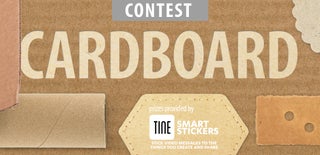Introduction: Genji Cosplay From Overwatch How and When to Use Cardboard for Cosplay
How and when to use Cardboard for cosplay
Step 1: Definitions and a Few Stuff We Need to Know
Corrugated cardboard is one of the most environmentally and reliable packaging materials, which is not exceeded in terms of economic and environmental performance by any other material. it is multipurpose material ,and chosen by arts and craft users on a regular basis.
In this Instructable I will be focusing on the most common type of cardboard found in house holds and that are easy to find , and the best uses for this cardboard regarding cosplay use, but first lets define what are the different types .
Depending on the notation and the country there are different standard ,here are a few
• Type II - is composed of a core and paper cover, joined by lines of adhesive between the corrugation peaks and the cover.
• Type III - is composed of a corrugated layer, sandwiched between two flat layers.
• Type V - is composed of two corrugated layers and three flat layers.
• Type VII - is composed of three corrugated layers and four flat layers.
So what does all mean ? Well basically what the what makes one cardboard different from another is its flat layers and how many corrugated layer it has (there is a broader definition but it would be too technical for this instructable )
Let me show a few cardboard boxes type III that I found around and where to find them .
Step 2: Where Do I Find Them
You can always buy these but recycling is always idea so here is a few tips on where
Step 3: B-flute 7.3 Mm Double Wall
Where to find ?
This cardboard I got from a TV set , but it can be found in most high-end electronics boxes like PC monitors, blenders, TV set ,computer Parts ,and those are just to name a few.
When to Use:
This is one of the most rigid cardboard , it has higher impact resistance so naturally its ideal use in cosplay is, but not limited to, weapons like swords spears and shields. It is very good for weapon templates too .
Where not to use
The disadvantage of this cardboard is that its not friendly with curves this becomes troublesome when templating or using for paper-craft that requires a lot of folding , so any armor that has many curves its use is not recommend.
Other uses :
To template furniture .
Step 4: A-flute 5 Mm
Where To find ?
Almost every box or a similar type of cardboard uses this type to transport (in my experience) most food products that are in Cans or gallons .
When to Use :
This provides a balance between stiffness and thinness ,when something requires a lot of curves in one direction this is a viable option .
Where not to use:
Paper-craft unfortunately this is too thick to make use in this situation .
Long swords and long weapons this does not provide or has the strength to support more then 2 feet of length without giving in to its own weight.
Other uses :
This too can be use to template furniture especially those that have very pronounce curves .
Step 5: B-flute 3 Mm
Where To find ?
This cardboard I got from a amazon boxes , Its one of the most common it can be found in most department stores and packaging .
When to Use
This is one is a little less the half the strength of that of the double wall B flute rigid cardboard , it has lower impact resistance so its ideal use in cosplay is 3 dimension short curves especially areas like the legs and chest .
I used this cardboard in combination with other types when making the template for the berserk Armor cosplay a while back in the leg area https://www.instructables.com/id/How-to-Build-Leg-Armor-Using-recycled-cans-or-shee/
Where not to use
Places like helmets and shoulders
Other uses
As a base material for fiberglass .
Step 6: D-flute 2 Mm
Where To find ?
Pizza boxes :D
When to Use :
This is great when you need to layer it on another material for decoration or fine details that need to overlap or stand out .
Where not to use:
This does not hold up to weight that good , the reason its good in pizza boxes is because of the outer layer and folds around it so anything that is going to put stress or wight on parallel to its surface is not a good idea .
Step 7: E-flute 1.5 Mm
Where To find ?
Shoe boxes , notebooks and some electronics .
When to Use
For places in paper-craft that require more strength like the back of armor , or legs especialy in places that will move or will move together , like knees and elbows . Its good on curves and excelent as a support material to mix with fiberglass
Where not to use
As a base for heavy armor it tears more easily then other cardboard.
Step 8: G-flute 0.5 Mm
Where To find ?
You can buy it or Cereal boxes .
When to Use
OMG this is so great when used with paper-craft you can print on it easily and it provides the idea thickness to stiffness ratio that support resins without compromising form , I use this for templates, paper-craft , base for fiber glass , fine details , it cuts like paper but because of its stiffness it make it 100 times more versatile.
Where not to use
Becomes mush very fast when in contact with sweat water or any liquid , when applying fiberglass you have to be care full in not damping it too much right away but rather slowly .
Step 9: Cosplay and Tips
- When cutting the cardboard be careful and always wear protection for hands like gloves .
- Thick (double layer B Flute ) cardboard requires a box cutter knife , using a new blade gives the best results .
- For A flute and lower a scissors can be used .
- When cutting for curves cut perpendicular to the line layer so that the curve can be achieved easier .
- Always cut the cardboard in more manageable smaller pieces if you are using a box cutter knife to avoid accidents .
Step 10: When Should I Use Cardbord As a Material and When Should I Use It As a Template for Another Material ?
Well it all come down to 5 things :
Does it need to stiff ?
A -B flute and double A or B
Does it need to be strong?
If it does then how strong from A to D are good options depending on how much
Will it touch my skin?
Then you need to wrap it with something that makes it water proof then it needs to be thinner so E or G
Will I cover it with another material?
Again if it does or not will depend on what to pick between A and G
Will it be used in a curve ?
If yes then D- G Flute
( I will try to make a flow diagram to better illustrate all this )
Step 11: Genji Cosplay (helmet Shoulder and Arm ) As an Exsample
Here I used different cardboard to template and fiberglass .
I template the arm and swords ,use Paper-craft on the helmet and shoulder ( that will later be fiber-glassed I will update this tutorial when that is completed ).
I made the shoulder with paper and paper-craft and the helmet in poster board (flute G) so you can see the difference of how much tape and fiber glass is necessary in both cases .
Step 12: Genji Wepons
For the sword blade I choose to use a template rather then to use cardboard to illustrate the main differences will be in the paint job and how rigid it is ( the upper sword is a aluminium composite ) . the handle will be made of wood I will post pic when completed.
Step 13: TL;DR Version Wrap Up
- Cardboard is essentially the same but will vary with the thickness.
- Cardboard is idea for templates but can be uses for many other things but each has its strength and weakness .
- Depending on the thickness to stiffness ratio it can be use form weapons to armor to paper-craft.
- Cardboard works great with other materials , but depending on the thickness so will its effect change .
The limit is basically you imagination , if you enjoyed this Instructables vote and share ,thank you for your patience and time !

Participated in the
Heroes and Villains Contest

Participated in the
Cardboard Contest 2016












